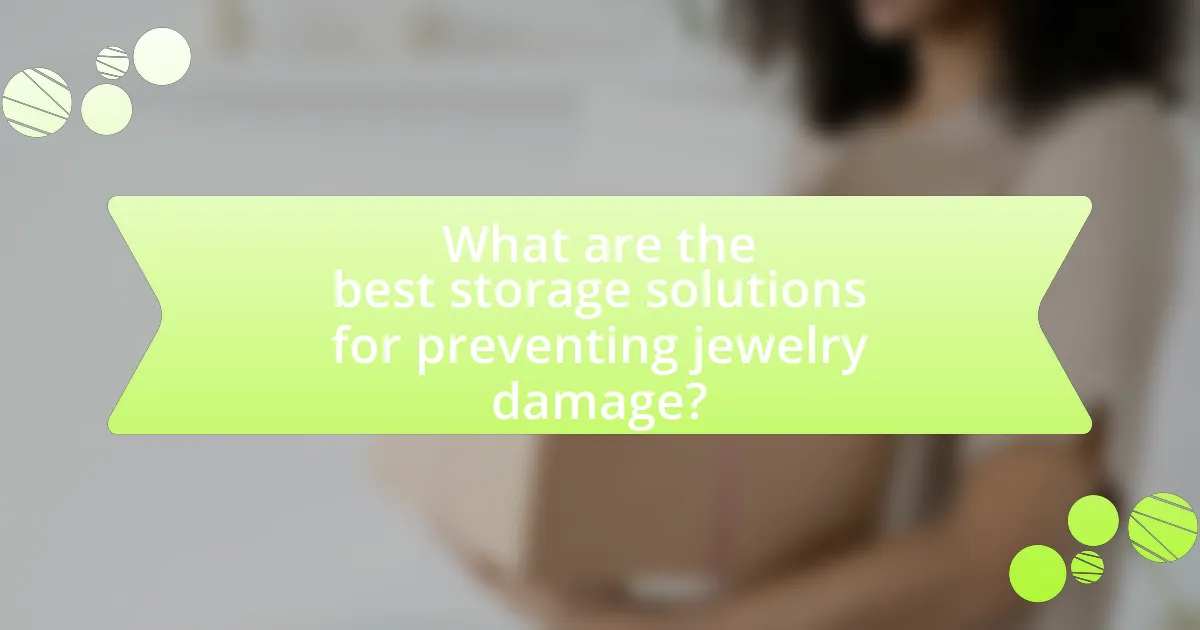The article focuses on the best storage solutions for preventing jewelry damage, emphasizing the importance of proper storage methods to maintain the integrity and longevity of jewelry pieces. Key solutions discussed include individual soft pouches, compartmentalized jewelry boxes, and anti-tarnish strips, each designed to minimize exposure to damaging elements such as moisture and air. The article also explores how different materials and organization techniques impact jewelry preservation, highlighting the significance of features like cushioning, secure closures, and humidity control. Additionally, it addresses common types of jewelry damage that can occur without proper storage and offers best practices for maintaining jewelry storage systems effectively.

What are the best storage solutions for preventing jewelry damage?
The best storage solutions for preventing jewelry damage include using individual soft pouches, dedicated jewelry boxes with compartments, and anti-tarnish strips. Individual soft pouches protect each piece from scratches and tangling, while jewelry boxes with compartments keep items organized and separated, reducing the risk of damage from friction. Anti-tarnish strips absorb moisture and prevent oxidation, which is particularly important for silver and other metals prone to tarnishing. These methods are effective because they minimize exposure to elements that can cause wear and tear, ensuring the longevity of jewelry pieces.
How do different storage methods impact jewelry preservation?
Different storage methods significantly impact jewelry preservation by influencing factors such as exposure to air, humidity, and physical damage. For instance, storing jewelry in airtight containers minimizes oxidation and tarnishing, which are common issues for metals like silver and gold. Additionally, using soft pouches or individual compartments prevents scratching and tangling, particularly for delicate pieces like chains and gemstones. Research indicates that humidity levels above 50% can accelerate corrosion, making climate-controlled storage preferable for long-term preservation. Therefore, selecting appropriate storage solutions directly correlates with the longevity and condition of jewelry items.
What types of storage solutions are available for jewelry?
Various types of storage solutions are available for jewelry, including jewelry boxes, organizers, display cases, and pouches. Jewelry boxes often feature compartments and soft lining to prevent scratches and tangling, while organizers can be drawer inserts or trays that keep pieces separated. Display cases provide a way to showcase jewelry while protecting it from dust and damage, and pouches offer a portable option for travel, typically made from soft materials to minimize friction. Each solution is designed to maintain the integrity of the jewelry and prevent damage over time.
How does the material of storage solutions affect jewelry safety?
The material of storage solutions significantly affects jewelry safety by determining the level of protection against physical damage, tarnishing, and environmental factors. For instance, soft materials like velvet or fabric can prevent scratches on delicate pieces, while hard materials like wood or metal can offer structural integrity and protection from crushing. Additionally, anti-tarnish materials, such as certain plastics or treated fabrics, can inhibit oxidation and tarnishing of metals, thereby preserving the jewelry’s appearance over time. Studies have shown that jewelry stored in anti-tarnish pouches can maintain their luster for longer periods compared to those stored in untreated materials, highlighting the importance of material choice in jewelry storage solutions.
Why is proper jewelry storage important?
Proper jewelry storage is important because it prevents damage, tarnishing, and loss of pieces. Storing jewelry correctly minimizes exposure to elements that can cause wear, such as moisture, air, and light. For instance, storing silver jewelry in anti-tarnish pouches can reduce tarnishing by up to 90%, according to the Jewelry Information Center. Additionally, using separate compartments for different types of jewelry prevents scratching and tangling, preserving the integrity and appearance of each piece.
What common types of jewelry damage can occur without proper storage?
Common types of jewelry damage that can occur without proper storage include scratches, tangling, tarnishing, and loss of stones. Scratches often happen when jewelry is stored together without protective barriers, leading to surface damage. Tangling occurs when chains and necklaces are not stored separately, causing knots that can be difficult to untangle and may lead to breakage. Tarnishing is a chemical reaction that affects metals like silver and can occur when jewelry is exposed to moisture and air without proper storage. Loss of stones can happen if settings are compromised due to improper handling or storage, increasing the risk of stones falling out. These damages highlight the importance of using appropriate storage solutions to maintain jewelry integrity.
How does environmental exposure contribute to jewelry damage?
Environmental exposure contributes to jewelry damage primarily through factors such as humidity, temperature fluctuations, and exposure to chemicals. High humidity can lead to tarnishing of metals like silver, while extreme temperature changes can cause materials to expand and contract, potentially leading to cracks or breaks. Additionally, exposure to chemicals found in household cleaners, perfumes, and even sweat can corrode or discolor jewelry. For instance, a study published in the Journal of Applied Chemistry highlights that prolonged exposure to chlorine can significantly degrade gold and silver alloys, confirming that environmental factors play a crucial role in the deterioration of jewelry.

What features should you look for in jewelry storage solutions?
When selecting jewelry storage solutions, prioritize features such as compartmentalization, soft lining, secure closures, and humidity control. Compartmentalization allows for organized storage, preventing tangling and scratching of pieces. Soft lining, often made from materials like velvet or felt, protects delicate surfaces from scratches. Secure closures, such as locks or magnetic clasps, ensure that jewelry remains safe and prevents loss. Humidity control features, like silica gel packets or airtight containers, help prevent tarnishing and damage from moisture. These features collectively contribute to the longevity and preservation of jewelry, making them essential in effective storage solutions.
How do organization and accessibility play a role in jewelry storage?
Organization and accessibility are crucial in jewelry storage as they prevent damage and facilitate easy retrieval. Proper organization, such as using compartments or trays, minimizes the risk of tangling and scratching, which can occur when jewelry is stored haphazardly. Accessibility ensures that items can be quickly located and removed without disturbing other pieces, reducing the likelihood of accidental damage. For example, a study by the American Society of Jewelry Historians highlights that organized storage systems can extend the lifespan of jewelry by up to 30% by preventing physical wear and tear.
What are the benefits of using compartments in jewelry storage?
Using compartments in jewelry storage prevents damage by organizing pieces and minimizing tangling. This organization allows for easy access and visibility, reducing the risk of scratching or breaking delicate items. Additionally, compartments can protect individual pieces from exposure to dust and moisture, which can lead to tarnishing or deterioration over time. Studies indicate that proper storage significantly extends the lifespan of jewelry, highlighting the importance of using compartments for effective preservation.
How can visibility enhance the care of your jewelry collection?
Visibility enhances the care of your jewelry collection by allowing for easier identification and access to each piece, which reduces the likelihood of damage from mishandling. When jewelry is stored in a way that makes it visible, such as in a display case or organized tray, owners can quickly assess their collection, ensuring that items are not tangled or scratched. Studies show that organized storage solutions can decrease the risk of loss and damage, as users are more likely to handle their jewelry with care when they can see and appreciate each piece.
What protective features are essential in jewelry storage solutions?
Essential protective features in jewelry storage solutions include soft lining, secure closures, and compartmentalization. Soft lining, such as velvet or felt, prevents scratches and damage to delicate surfaces. Secure closures, like locks or magnetic clasps, protect against theft and accidental openings. Compartmentalization, through trays or dividers, minimizes tangling and allows for organized storage, reducing the risk of damage. These features collectively enhance the longevity and condition of jewelry by safeguarding it from physical harm and environmental factors.
How do anti-tarnish properties help in preserving jewelry?
Anti-tarnish properties help in preserving jewelry by preventing the formation of tarnish, which is a chemical reaction that occurs when metals, particularly silver, react with sulfur compounds in the air. This reaction leads to a dull, discolored surface that diminishes the jewelry’s aesthetic appeal. Anti-tarnish treatments, such as coatings or the use of specific materials, create a barrier that inhibits this reaction, thereby maintaining the jewelry’s shine and integrity over time. Studies have shown that jewelry stored in anti-tarnish pouches or boxes can remain tarnish-free for extended periods, significantly reducing the need for frequent cleaning and restoration.
What role does cushioning play in preventing jewelry damage?
Cushioning plays a critical role in preventing jewelry damage by providing a protective barrier that absorbs shock and minimizes movement. When jewelry is stored or transported, cushioning materials such as foam, fabric, or soft padding prevent direct contact between pieces, reducing the risk of scratches, dents, or breakage. Studies have shown that jewelry stored with adequate cushioning experiences significantly lower rates of damage compared to those without, highlighting the importance of cushioning in maintaining the integrity of delicate items.

What are some popular types of jewelry storage solutions?
Popular types of jewelry storage solutions include jewelry boxes, organizers, and display cases. Jewelry boxes often feature compartments and soft linings to prevent scratches and tangling, making them ideal for storing various types of jewelry. Organizers, such as trays and drawer inserts, provide a systematic way to categorize and access pieces easily. Display cases, often used for showcasing jewelry, can also serve as protective storage, keeping items visible while safeguarding them from dust and damage. These solutions are widely recognized for their effectiveness in maintaining the condition of jewelry over time.
How do jewelry boxes compare to other storage options?
Jewelry boxes provide superior protection for jewelry compared to other storage options such as drawers or open trays. Jewelry boxes are specifically designed with compartments and soft linings that prevent scratches and tangling, which is crucial for maintaining the integrity of delicate pieces. In contrast, drawers may lead to items being jumbled together, increasing the risk of damage, while open trays expose jewelry to dust and potential loss. Studies indicate that proper storage in dedicated jewelry boxes can extend the lifespan of jewelry by minimizing exposure to environmental factors and physical wear.
What are the advantages of using a jewelry roll or pouch?
Using a jewelry roll or pouch offers several advantages, primarily in protecting and organizing jewelry. Jewelry rolls and pouches prevent tangling and scratching by providing individual compartments or soft fabric that cushions each piece. This organization minimizes the risk of damage during travel or storage, as items are less likely to collide with one another. Additionally, these storage solutions are often compact and portable, making them ideal for travel, as they can easily fit into luggage without taking up much space. The use of a jewelry roll or pouch also enhances accessibility, allowing users to quickly find and retrieve specific pieces without rummaging through a cluttered box.
How do display cases contribute to jewelry protection?
Display cases contribute to jewelry protection by providing a controlled environment that minimizes exposure to dust, moisture, and physical damage. These cases often feature glass or acrylic fronts that shield jewelry from external elements while allowing visibility for display. Additionally, many display cases are designed with compartments or cushioned interiors that prevent pieces from scratching or tangling with one another. The use of display cases can significantly reduce the risk of tarnishing and wear, as they limit contact with air and pollutants. Studies indicate that proper storage solutions, including display cases, can extend the lifespan of jewelry by up to 50% by preventing common forms of damage.
What innovative storage solutions are available for jewelry enthusiasts?
Innovative storage solutions for jewelry enthusiasts include modular jewelry organizers, anti-tarnish pouches, and smart jewelry boxes. Modular organizers allow for customizable configurations, enabling users to arrange their pieces according to size and type, which minimizes tangling and damage. Anti-tarnish pouches are designed with materials that prevent oxidation, preserving the shine of silver and other metals. Smart jewelry boxes incorporate technology to track inventory and provide alerts for maintenance, ensuring that pieces are stored safely and securely. These solutions effectively address common issues such as tangling, tarnishing, and loss, making them ideal for jewelry enthusiasts.
How can smart storage solutions enhance jewelry care?
Smart storage solutions enhance jewelry care by providing optimal organization, protection, and environmental control. These systems often include features such as humidity control, UV protection, and anti-tarnish materials, which help to maintain the integrity and appearance of jewelry over time. For instance, a study by the Gemological Institute of America highlights that controlled environments can significantly reduce tarnishing and degradation of precious metals and gemstones. By utilizing smart storage solutions, jewelry owners can effectively minimize damage caused by exposure to air, light, and moisture, ensuring their pieces remain in pristine condition.
What are the benefits of modular storage systems for jewelry?
Modular storage systems for jewelry offer enhanced organization, protection, and customization. These systems allow users to arrange their jewelry in a way that minimizes tangling and scratching, which are common causes of damage. Additionally, modular designs can be tailored to fit various types of jewelry, accommodating different sizes and styles, thus maximizing space efficiency. The ability to easily rearrange or expand the storage as needed further supports long-term usability and adaptability, ensuring that jewelry remains in optimal condition.
What are some best practices for maintaining jewelry storage?
To maintain jewelry storage effectively, it is essential to keep jewelry organized and protected from damage. Using individual compartments or soft pouches prevents pieces from tangling and scratching each other. Additionally, storing jewelry in a cool, dry place away from direct sunlight helps to prevent tarnishing and fading. For example, using anti-tarnish strips or cloths can further protect silver and other metals from oxidation. Regularly cleaning jewelry with appropriate methods also ensures that dirt and oils do not accumulate, which can lead to deterioration over time. These practices are supported by recommendations from jewelry care experts, emphasizing the importance of proper storage to extend the life of jewelry items.
How often should you clean and organize your jewelry storage?
You should clean and organize your jewelry storage at least once every three to six months. Regular cleaning prevents tarnishing and damage, as dust and moisture can accumulate over time, leading to deterioration of materials. Additionally, organizing your jewelry helps you keep track of pieces, reducing the risk of loss or damage. Studies indicate that proper maintenance of jewelry storage can extend the lifespan of your items significantly, ensuring they remain in good condition for years.
What tips can help you maximize the lifespan of your jewelry storage solutions?
To maximize the lifespan of your jewelry storage solutions, ensure that you store jewelry in a cool, dry place to prevent moisture damage. Moisture can lead to tarnishing and corrosion, particularly for metals like silver and gold. Additionally, using anti-tarnish pouches or cloths can further protect your pieces from oxidation. Organizing jewelry in separate compartments or using soft-lined boxes prevents scratching and tangling, which can cause physical damage over time. Regularly cleaning your storage solutions and checking for any signs of wear or damage also contributes to their longevity. These practices are supported by industry standards that emphasize the importance of proper storage conditions for maintaining jewelry quality.
